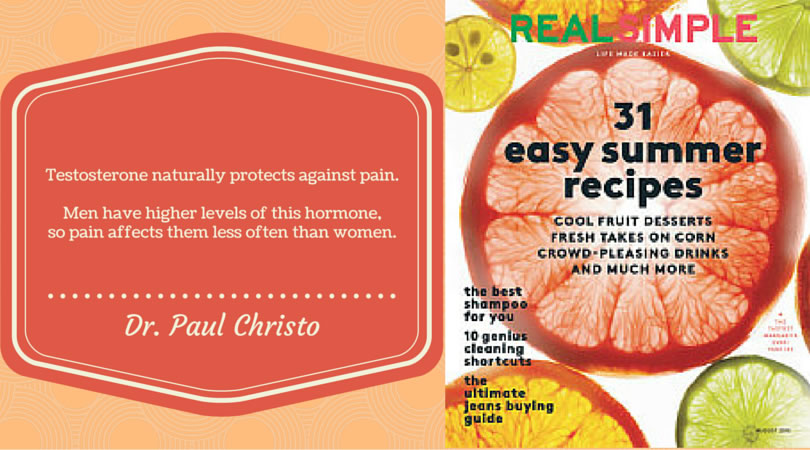The way men’s and women’s bodies trigger and respond to pain is just one more difference between the two genders.
You can tell if someone is at greater risk than others for developing chronic pain later in life from the very moment they are born. How can this be? A majority of the 100 million Americans in pain are women. This means that simply being female increases the likelihood that you will be diagnosed with a chronic pain condition in your lifetime.
Real Simple magazine and writer Amy Paturel put the growing epidemic of chronic pain in the spotlight for the August 2015 print issue article “Pain. Your body’s most important warning system—and what to do when it goes awry.”
Women make up somewhere between 80 to 90 percent of fibromyalgia sufferers- but what is it about the female gender that predisposes them to pain?
Like many other differences between the genders, it comes down to hormones, which have been found to significantly impact the way men and women feel pain.
Here’s a simplified breakdown of how hormones alter the path of pain:
- Testosterone naturally protects against pain. Men have higher levels of this hormone, so pain affects them less often than women.
- Estrogen can limit the activity of a gene called COMPT. This process causes the body to hoard stress hormones, which then sends a loud and clear alert to the nerves, telling them, “Intensify the pain!”
- Natural female processes like the menstrual cycle, pregnancy and perimenopause have the power to throw hormones into a tailspin. These hormonal fluctuations can often amplify or at least “encourage” the level of discomfort a woman is experiencing during the already painful situation.
Medicines and mind-body techniques can be a great asset to women (and men) who are in pain. Acetaminophen (Tylenol) in doses totaling less than 4,000 milligrams a day is a good place to start. For Ibuprofen (Motrin) or naproxen (Aleve), take as directed for pain or inflammation. Of course, if the pain worsens or continues for a period of two weeks or more, make an appointment with your doctor to explore any underlying issues or medical conditions.
Ms. Paturel also spoke with University of Michigan Fibromyalgia expert Dr. Daniel Clauw, whom I interviewed for a past episode of Aches and Gains along with actress A.J. Langer. Dr. Clauw provided a very effective mind-body technique: Anticipating relief.
“Research has shown that a placebo can be as effective as a strong dose of morphine,” Dr. Clauw said.
I tell my patients: “reframe your pain.” This concept involves transforming the way you view pain. Imagining pain as something more positive.
For example, you might reframe the pain of a burn as a tingling sensation. It won’t make the discomfort miraculously disappear, but it will give you more control over your emotional response, which can reduce the pain’s intensity.
Browse the Aches and Gains archives for past episodes featuring interviews with celebrities, advocates and prominent experts.
Listen and download podcasts for shows with the late Maya Angelou on overcoming emotional and physical pain, Montel Williams on his battle with multiple sclerosis and numerous other public figures and pain specialists.

